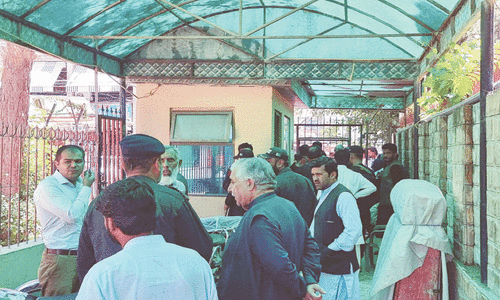WASHINGTON, April 27: The International Monetary Fund predicted on Wednesday that Pakistan’s real GDP growth may to fall to 2.8 per cent in fiscal 2010-11.
The Fund cites last year’s devastating floods and high fiscal deficits as the main causes for this shortfall, noting that deficits were crowding out private-sector credit and investment.
The IMF’s “2011 Regional Outlook for Middle East and Central Asia” also examines the impact of higher fuel and food prices on the country’s economy, noting that Pakistan’s import bill was 2.1 per cent of its GDP and the annual cost of subsidies provided to cushion the impact of this price hike was 0.3 per cent of GDP.
The government had suspended regular monthly adjustments of petroleum product prices between November 2010 and March 2011. The report also notes that Pakistan’s equity market has fallen about five per cent during the current fiscal year.
“Pakistan is projected to record markedly lower growth in 2011 than in 2010, but primarily for reasons unrelated to regional unrest,” the report says.
The IMF includes Pakistan among the countries that are registering annual headline inflation of above 10 per cent and warns that “monetisation of the fiscal deficit is an added concern.”
According to the report, Pakistan earned $24 billion in 2008 from exports of goods and services, which decreased to $23.2 billion in 2009 but increased to $24.9 billion in 2010. In 2011, it is projected to increase to $28.5 billion.
In 2008, Pakistan spent $45.4 billion on imports of goods and services, which decreased to $39.2 billion in 2009 but increased to $38.1 billion in 2010. In 2011 it is projected to increase to $42.7 billion.
Pakistan’s gross official reserves in 2008 were $8.6 billion. In 2009, the reserves increased to $9.1 billion, in 2010 to $13.0 billion and in 2011 projected to increase to $13.6 billion.
Pakistan’s general government total revenue, excluding grants in 2008 was 14.6 per cent of GDP, in 2009 it was 14.5 per cent, in 2010, 14.2 per cent and in 2011 it is projected at 13.5 per cent.
The country’s general government total expenditure and net lending in 2008 was 22.2 per cent of GDP, in 2009, 19.9 per cent, in 2010, 20.5 per cent and in 2011 it is projected at 18.8 per cent.
Pakistan’s total government gross debt in 2008 was 58.7 per cent of GDP, in 2009, 57.3 per cent, in 2010, 56.8 per cent, and in 2011 it is projected at 54.1 per cent.
Total government net debt in 2008 was 53.7 per cent of GDP, in 2009, 53.5 per cent, in 2010, 53.2 per cent, and in 2011 it is projected at 50.5 per cent.
Pakistan’s current account balance in 2008 was minus $13.9 billion. In 2009, it was minus $9.3 billion, in 2010 minus $3.9 and in 2011 it is projected at minus $3.1 billion.
The real GDP growth in 2008 was 1.6 per cent, in 2009 it was 3.4 per cent, in 2010 it was 4.8 per cent and in 2011 it is projected at 2.8 per cent.










































Dear visitor, the comments section is undergoing an overhaul and will return soon.